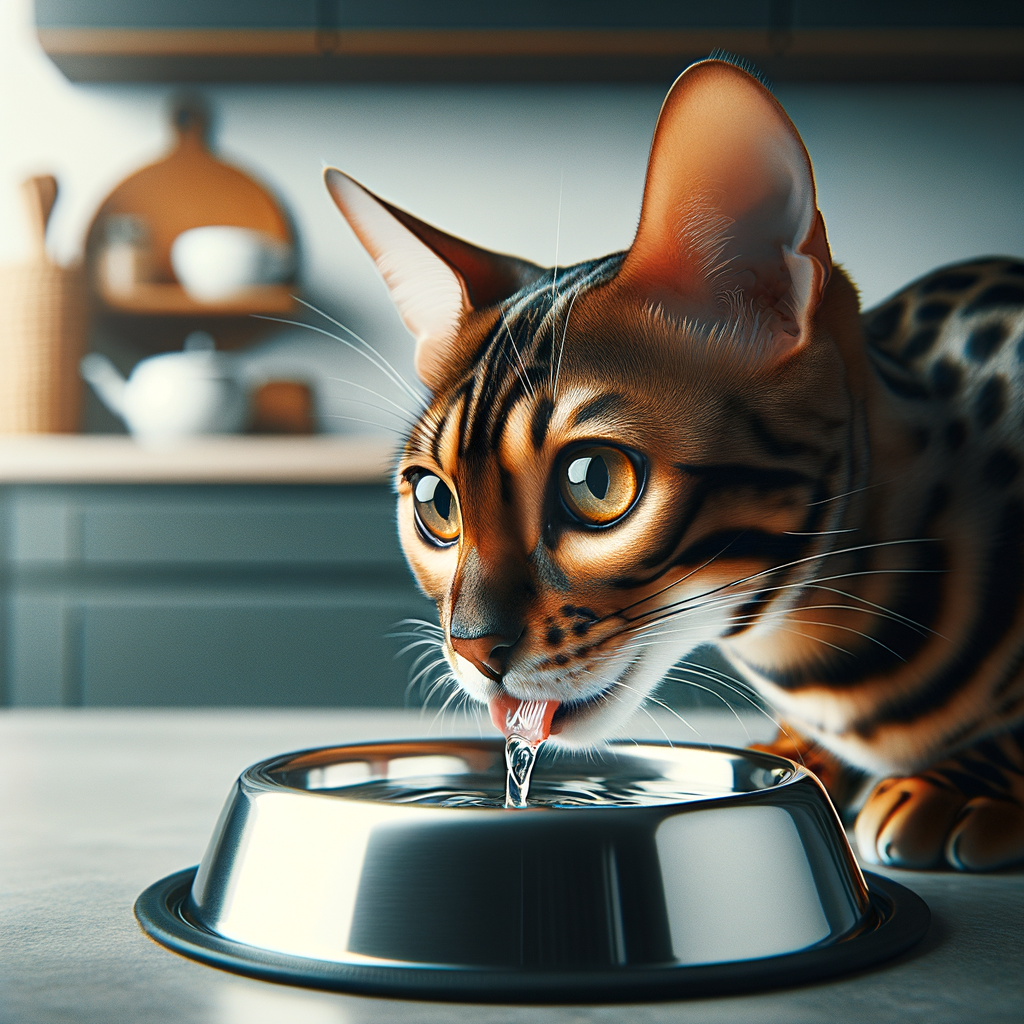
Introduction to Bengal Cats and Their Unique Needs
- Overview of Bengal Cat Breed
Bengal cats are a popular breed known for their wild appearance and playful nature. They are a hybrid breed, originally created by crossing domestic cats with the Asian leopard cat. Bengals are medium to large in size and have a sleek, muscular build.
-
Unique Characteristics of Bengal Cats
- Coat and Patterns: Their coats are short, dense, and come in various patterns like spots and rosettes, resembling a leopard.
- High Energy Levels: Bengals are very active and love to climb, jump, and play.
- Intelligence: They are highly intelligent and can learn tricks and commands easily.
-
Specific Health Needs of Bengal Cats
- Diet: Bengals require a high-protein diet to support their active lifestyle.
- Hydration: Ensuring they drink enough water is crucial for their kidney health.
- Regular Vet Check-ups: Regular visits to the vet can help catch any health issues early.
The Importance of Water for Bengal Cats
-
Why Hydration is Vital for Bengal Cats
Water is essential for all cats, but Bengal cats need it even more. They are very active and playful. This means they lose water faster. Drinking enough water helps them stay healthy and happy.
-
Common Health Issues Related to Dehydration
- Kidney problems
- Urinary tract infections
- Dry skin and coat
These health issues can make your Bengal cat feel very sick. Make sure they drink enough water every day.
-
Hydration Benefits for Bengal Cats
- Better digestion
- Healthy skin and coat
- More energy for play
Keeping your Bengal cat hydrated helps them live a longer, healthier life.
Bengal Cat Water Needs
Understanding Bengal Cat Water Intake
-
How Much Water Should a Bengal Cat Drink Daily:
Bengal cats need about 3.5 to 4.5 ounces of water per 5 pounds of body weight each day. For example, a 10-pound Bengal cat should drink around 7 to 9 ounces of water daily. Ensuring they get enough water is crucial for their health.
-
Factors Affecting Bengal Cat Water Intake:
- Diet: Cats that eat dry food need more water compared to those eating wet food.
- Activity Level: Active Bengal cats may require more water to stay hydrated.
- Environment: Hot and dry climates can increase a cat’s water needs.
- Health: Certain health conditions, like kidney disease, can affect how much water a cat needs.
| Weight of Bengal Cat | Daily Water Intake |
|---|---|
| 5 pounds | 3.5 – 4.5 ounces |
| 10 pounds | 7 – 9 ounces |
| 15 pounds | 10.5 – 13.5 ounces |
Keeping Bengal Cats Hydrated
-
Providing Fresh Water Daily
Cats are picky about their water, and they prefer it clean and cool. Make sure to change the water at least once a day to keep it fresh.
According to Wikipedia, cats need around 3.5 to 4.5 ounces of water per 5 pounds of body weight daily. This means a 10-pound Bengal cat should drink about 7 to 9 ounces of water each day.
-
Using Cat Water Fountains
Cat water fountains can be a great way to encourage your Bengal cat to drink more water. These fountains keep the water moving, which many cats find more appealing than still water.
Studies show that cats are more likely to drink from running water sources. A cat water fountain can help ensure your Bengal cat stays hydrated.
-
Feeding Wet Food
Another effective way to keep your Bengal cat hydrated is by feeding them wet food. Wet food contains a high percentage of water, which helps your cat stay hydrated.
For example, wet cat food can contain up to 78% water. This can significantly contribute to your cat’s daily water intake.
| Tip | Benefit |
|---|---|
| Providing Fresh Water Daily | Keeps water clean and appealing |
| Using Cat Water Fountains | Encourages more drinking |
| Feeding Wet Food | Increases water intake through diet |
Bengal Cat Hydration Tips
Encouraging Bengal Cats to Drink More Water
-
Using Flavored Water:
Some Bengal cats are picky about drinking plain water. You can try adding a bit of tuna juice or chicken broth to their water to make it more appealing. Make sure the added flavors are safe for cats and do not contain any harmful ingredients.
-
Placing Water Bowls Strategically:
Place water bowls in different areas around your home. Bengals are curious and active, so having multiple water sources can encourage them to drink more. Ensure the bowls are in quiet and accessible locations.
-
Changing Water Regularly:
Cats prefer fresh water. Change your Bengal cat’s water at least once a day. Clean the bowls regularly to prevent bacteria buildup. Fresh, clean water is more likely to attract your cat to drink.
Recognizing Signs of Dehydration in Bengal Cats
-
Checking for Dry Gums:
To check, gently lift your cat’s lip and touch their gums. Healthy gums should be moist and pink. If they feel dry or sticky, your cat may be dehydrated.
-
Pinch Test for Skin Elasticity:
Gently pinch the skin between your cat’s shoulder blades and then release it. In a well-hydrated cat, the skin should snap back quickly. If the skin stays up or returns slowly, it could be a sign of dehydration.
-
Monitoring Urination Habits:
A decrease in urination or darker, more concentrated urine can indicate dehydration. Ensure your cat has access to fresh water at all times and consult your vet if you notice any changes in their urination habits.
Bengal Cat Health and Hydration
Case Study: Hydration and Kidney Health in Bengal Cats
In this case study, we explore the importance of hydration and how it can prevent kidney disease in these unique felines.
- Importance of Hydration for Kidney Function: Water is essential for the kidneys to filter waste from the blood. Without enough water, toxins can build up, leading to serious health issues.
- How Proper Hydration Can Prevent Kidney Disease: Ensuring your Bengal cat drinks enough water can help prevent kidney disease. Proper hydration keeps the kidneys functioning well, reducing the risk of chronic kidney problems.
| Hydration Benefits | Impact on Kidney Health |
|---|---|
| Flushes out toxins | Prevents toxin buildup |
| Maintains electrolyte balance | Supports kidney function |
| Promotes healthy urine flow | Reduces risk of kidney stones |
According to Wikipedia, kidney disease is a common issue in cats, especially as they age. By ensuring your Bengal cat stays hydrated, you can help them live a healthier, longer life.
Key Takeaways: Hydration for Bengal Cats
-
Importance of Regular Water Intake:
Bengal cats need to drink water regularly to stay healthy. Water helps their bodies function properly. Without enough water, they can get sick. Make sure your Bengal cat always has fresh water available.
-
Effective Hydration Strategies for Bengal Cats:
There are many ways to keep your Bengal cat hydrated. You can use a water fountain, as many cats prefer running water. Adding wet food to their diet can also help. Some cats like ice cubes in their water bowl. Find what works best for your cat.
-
Recognizing and Addressing Dehydration:
Dehydration can be dangerous for Bengal cats. Signs of dehydration include dry gums, lethargy, and sunken eyes. If you notice these signs, encourage your cat to drink water and contact your vet. Early action can prevent serious health problems.






